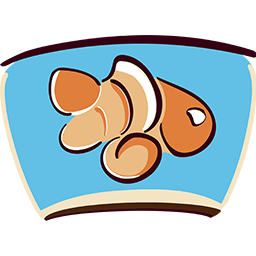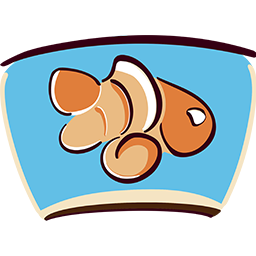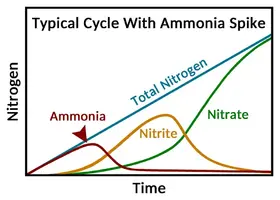Ammonia (NH3) is the first toxin that is created and is one of the most highly toxic ones throughout the stages. Slowly beneficial bacteria will build up and break down this ammonia into nitrite (NO2) which is less toxic. Once again, the beneficial bacteria that break down nitrite slowly build up to turn this into nitrate (NO3). Although nitrate is less toxic than the previous three, at high concentrations it can be fatal to most inhabitants inside of your aquarium. In a freshwater aquarium, live plants will help out by absorbing all three of the toxins in the previous stages and releasing oxygen back into the water during the day. Likewise, saltwater coral and live rock will with absorbing these and help complete a cycle as well. Please also make sure to always use a water de-chlorinator when doing water changes, since any amount of chlorine will kill off any beneficial bacteria.
Now, we cannot just buy these beneficial bacteria as they must be seeded onto your filter media on their own. If they are exposed to air at all, they will slowly die off even if it's just for a few minutes. Therefore, we must find a way to build up ammonia so that the bacteria can build upon their own with our equipment. This is called cycling, and there are a few methods to do this each has its positives and negatives associated with each method. Please be aware that cycling an aquarium can take anywhere from a minimum of 1 week upward to months at a time depending on how much filter media your aquarium has, what method you are using, and the concentration of waste that your aquarium generates on its own.
When cycling, everyone will follow the same trend shown within the graph, where ammonia spikes first, as it starts to decrease then nitrite will spike. As a small note, ammonia levels might remain slightly elevated following an ammonia spike. Any tank with livestock will always have some level of total ammonia, even if it's not detectable by our test kits due to the nature of organic waste always being produced. Lastly, as nitrite decreases then nitrate will spike and continue to increase unless water changes are done periodically or if there are plants (for freshwater tanks) or corals and plants (for saltwater tanks) to consume nitrate as a nutrient.
Aquariu.ms highly recommends the API Master Test Kit during all cycling methods, as test strips are highly inaccurate and can cause false positives or false negatives.
Fishless Cycling
This method of cycling involves adding no fish or invertebrates inside the aquarium and is by far the safest and easiest method. By not having any inhabitants inside the aquarium, you are allowing for all of the correct amounts of beneficial bacteria to grow at a rate where you can fully stock your aquarium once you are done. There are some heavy negatives to this method, as you will be unable to stock your aquarium with any fish or invertebrates during this time.
Steps & Maintenance
- Add in your selected source of ammonia (can be a dead fish, dead invertebrate, pure ammonia bottle, fish food, etc.) to raise the level to 4PPM. Do not turn on your setup's lights at any point since algae will form as we are creating perfect conditions for it.
- Start testing once a week for ammonia to start to decline, it might take only a few days and sometimes it can take up to a few weeks. When you see ammonia starts to decline then you know that your cycle has started, and get ready for the concentrations to rise quickly and then fall slowly. Once the readings show any ammonia below or at 1PPM then you know it's time to add in more ammonia from your source to bring it back up to 4PPM.
- Start testing for ammonia and nitrite twice a week, you'll slowly start to see that ammonia is falling quickly and that nitrites are starting to rise. Once the readings show any ammonia below or at 1PPM then you know it's time to add in more ammonia from your source to bring it back up to 4PPM. If the readings start to slow nitrites slowly falling then you want to test for nitrates.
- Start testing for ammonia, nitrite, and nitrates every other day. At this point, we want to make sure that ammonia can get turned into nitrite, and then nitrate within a day or two. If you ever get to the point where they are off the charts, feel free to do a 50-60% water change.
- If it can turn your ammonia source into nitrites, and then nitrates within a day or two then your setup is now fully cycled, and ready for its inhabitants. Congratulations!
Fish-in Cycling
This method of cycling involves adding some hardy fish or invertebrates inside of the setup during the whole cycle and is by far the method to use if you want your setup to not look empty for weeks. There are some very heavy negatives to this method since you will need to always be on top of the water parameters every day (as if the various toxin levels get above 0.25PPM then you need to do a water change). Another negative is that during this method, you are putting heavy stress on any fish and/or invertebrates that you keep inside. A common sign is red gills, lacking an appetite, staying in one place, or trying to jump outside of the setup if at all possible. These can all be reduced if you stay on top of the water changes and make sure to do all of the tests required for each step.
Steps & Maintenance
- Add in your selected hardy fish and/or invertebrates, making sure that they are a known hardy species as anything delicate will most likely die during this method.
- Start testing every other day for ammonia to show up, it might take only a day and sometimes it can take up to a few weeks. When you see ammonia you know that your cycle has started, and to get ready for the concentrations to rise quickly and then fall slowly. Once the readings show any ammonia above or at 0.25PPM then you know it's time for a 25-50% water change.
- Start testing for ammonia and nitrite every other day, you'll slowly start to see that ammonia isn't building up as quickly as before and that nitrites are starting to rise. Continue doing the tests and water changes for ammonia, as it will not harm the nitrite stage. Once the readings show any nitrite above 0.25PPM then you know it's time for a 25-50% water change.
- Start testing for ammonia, nitrite, and nitrates every other day. You'll slowly start to see that ammonia should be near or under control by the beneficial bacteria now, nitrites shouldn't be building up as quickly as before and nitrates are starting to rise. Continue doing the tests and water changes for ammonia and nitrite, as it will not harm the nitrate stage. Now you will be doing a weekly water change of 20% for the lifetime that you have the setup since you must manually lower the nitrates as there are not any beneficial bacteria that break this toxin down.
- If it can turn your ammonia into nitrites, and then nitrates within a day or two your aquarium is now fully cycled, and ready for its inhabitants. Congratulations!
Pond and Live Plants Cycling
This method involves the use of over-planting using freshwater plants so that they can soak up any of the toxins and allow for you to have fish right away. This method is one of the most commonly used in planted aquariums and is the reason why ponds can be set up in a matter of days and stocked fully without any real cycling required. There are some negatives to this, which include the fact that you must know what types of plants you want inside of your setup, you must know how to take full care of them so that they do not die and cause even more toxins to be in the water, and that you still will have to do water checks however not as frequently as the above methods.
Live Rock Cycling
This method involves the use of adding in live rock (uncured or cured) which contains a ton of micro-bacterial life that has a lot of nitrifying beneficial bacteria. This type of beneficial bacteria is alive on the rock and allows you to be able to add fish or other types of life to the tank for an almost instant cycle. A good point to note that, is sometimes live rock can contain a lot of different pest life such as bristle worms, invasive types of starfish that will overpopulate your tank, and even different types of life that were just awaiting correct water (snails, some fish eggs, etc.). Ideally, we will recommend that you wait until ammonia drops into safe levels (at or below 0.25PPM) before adding any live rock to the tank. This is the same when using cured live rock, or uncured live rock, which may have different levels of bacteria dying off dependent on how long it was shipped and the container.
As a note, most cured live rock is picked up at a local location to be moved quickly, whereas uncured is shipped and has a decent amount of bacteria dying off even when it's submerged through the shipment process. Uncured can provide some of the bacteria that have died off which will help automatically start the first phase of the cycle, but does require some additional time to be able to generate the nitrite-converting bacteria. This is why a majority of those who are trying to use this method, tend to look for cured live rock vs. uncured live rock due to their additional cycle time.
Starting Bacteria Products
Many various products claim to create an established cycle in your setup within a matter of days while also not being maintained at a stable temperature (refrigerated for example). Sadly, most if not all of these products do not create nor help an established cycle but instead prolong the time frame required to stabilize a cycle. A handful of these products will contain traces of decaying matter, in which ammonia will be added into the water (at a very dilute form) to kick start it faster, while others will state that they are able to get the nitrifying bacteria to go into a state of hibernation so that they may be brought back to life when they come into contact with oxygen. Many questions arise when they want to know, is worth buying and/or using, how fast this speed up my cycle, and what are the possible risks of using it. Since there aren’t any scientopic studies from any aquarium owners outside of the personal anecdotal experiences that they work every time, and many examples of how they do not, we still recommend that any owner using such products do so with a close eye to validate the product's claims.


